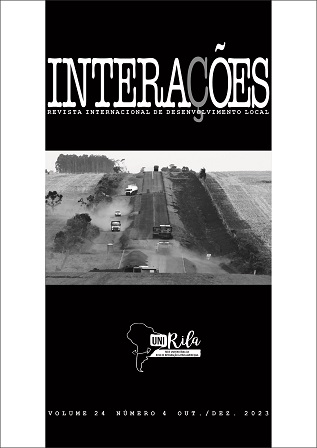Las redes de actores en el Corredor Vial Bioceánico “Mato Grosso do Sul – Puertos del Norte de Chile”: diagnóstico y propuesta de una gobernanza multinivel
Palabras clave:
Corredor Vial Bioceánico, América del Sur, integración de infraestructura, gobernanciaResumen
El Corredor Vial Bioceánico (CVB) entre Brasil, Paraguay, Argentina y Chile es un proyecto cuyo
principal objetivo es ofrecer nuevas oportunidades de desarrollo las regiones periféricas y sin acceso al mar
del trópico de Capricornio. Sin embargo, la transformación regional necesita algo más que la construcción de
infraestructura. Particularmente requiere una coordinación efectiva entre distintos actores para alcanzar el
desarrollo. El objetivo principal de este artículo es proporcionar una explicación detallada sobre la estructura
de la red de actores del CVB, así como proponer un enfoque potencial de gobernanza que facilite una mejor
coordinación entre los participantes. A través de un análisis de redes sociales (Social Network Analysis [SNA])
hicimos una exploración de las dinámicas de participación y toma de decisiones entre los diferentes actores
involucrados. Los principales hallazgos muestran una baja participación del sector privado, pocos vínculos
transnacionales (mayores interacciones entre actores del mismo país), pocos vínculos entre actores de
gobierno nacional y subnacional-local, y poca participación del gobierno nacional en Argentina. Con respecto
a la propuesta de gobernanza, se sugiere la creación de dos nuevas mesas (Desarrollo Social y Ambiental, y
Seguridad Fronteriza), la promoción de misiones empresariales con una visión de integración regional y la
preservación de los avances del Grupo de Trabajo del CVB.
Citas
ACTA DECLARACIÓN DE ASUNCIÓN SOBRE CORREDORES BIOCEÁNICOS. Assunción, Paraguay, 2015.
ACTA DECLARACIÓN DE BRASILIA SOBRE CORREDORES BIOCEÁNICOS. Brasília, DF, Brasil, 2017.
BARROS, P. S; GONÇALVES, J. S. B. O protagonismo do Mato Grosso do Sul para a resiliência do Corredor
Rodoviário Bioceânico. Monções: Revista de Relações Internacionais da UFGD, v. 10, n. 19, p. 105-28, 2021.
BRASIL. Ministério das Relações Exteriores. Nota a la prensa n. 217. Consenso de Brasilia. Brasília, DF,
maio 2023.
COMISIÓN ECONÓMICA PARA AMÉRICA Y EL CARIBE [CEPAL]. Integración regional: hacia una estrategia de
cadenas de valor inclusivas. [s.l.]: CEPAL, 2014. Disponível em: https://www.cepal.org/pt-br/node/24749.
Acesso em: 10 jun. 2023.
COPUS, A. K.; DE LIMA, P. Territorial cohesion in rural Europe. [s.l.]: Routledge, Taylor y Francisc Group, 2015.
DANNENBERG, P.; DIEZ, J. R.; SCHILLER, D. Spaces for integration or a divide? New-generation growth corridors
and their integration in global value chains in the Global South. Zeitschrift für Wirtschaftsgeographie,
[s.l.], v. 62, n. 2, p. 135-51, 2018.
GOBIERNO DE SALTA. Tercer Foro de los Territorios Subnacionales del Corredor Bioceánico de Capricornio:
Declaración De Salta. Salta, 2023. Disponível em: https://www.semadesc.ms.gov.br/wp-content/
uploads/2023/04/Declaracion-de-Salta-Tercer-Foro-de-los-Territorios-Subancionales-el-CBC.pdf. Acesso
em: 10 jun. 2023.
DUNFORD, M.; LIU, W. Chinese perspectives on the Belt and Road Initiative. Cambridge Journal of Regions,
Economy and Society, [s.l.], v. 12, n. 1, p. 145-167, 2019.
FRANCO, L.; GONÇALVES, J. D. S. B.; ATIENZA, M.; BARROS, P. S. Redes de actores y su rol en el desarrollo
de corredores: diagnóstico y propuesta de gobernanza para el corredor bioceánico vial Mato Grosso do
Sul – puertos del norte de Chile. Brasília: Ipea, 2023. 79 p.
GRAPPI, G. Asia’s era of infrastructure and the politics of corridors: decoding the language of logistical
governance. Logistical Asia: The labour of making a world region, 2018. p. 175-98.
HOPE, A.; COX, J. Development corridors. Coffey International Development, [s.l.], n. 12, 2015.
HOWLETT, M., KEKEZ, A.; POOCHAROEN, O. O. Understanding co-production as a policy tool: Integrating
new public governance and comparative policy theory. Journal of Comparative Policy Analysis: Research
and Practice, v. 19, n. 5, p. 487-501, 2017.
KUNAKA, C.; CARRUTHERS, R. Trade and transport corridor management toolkit. [s.l.]: World Bank
Publications, 2014.
MAGENNIS, E.; CORRIGAN, J.; BLAIR, N.; BROIN, D. Ó. Planning a Dublin-Belfast Economic Corridor:
Networks, engagement and creating opportunities. Administration, [s.l.], v. 69, n. 4, p. 57-82, 2021.
ÖBERG, M. Governance structure for transport corridors. Dissertation (Doctoral) – Luleå Tekniska
Universitet, 2014.
SANGUINETTI, P.; MONCARZ, P.; VAILLANT, A, ALLUB, L.; JUNCOSA, F.; BARRIL, D.; CONT, W.; Y LALANNE, Á.
Caminos para la integración: facilitación del comercio, infraestructura y cadenas globales. de valor, 2021
SCOTT, J. W. European and North American contexts for cross-border regionalism. Regional studies, v.
, n. 7, p. 605-17. 1999.
SEQUEIRA, S.; HARTMANN, O.; KUNAKA, C. Reviving trade routes: evidence from the maputo corridor.
Sub-Saharan Africa Transport Policy Program (SSATP) discussion paper, n. 14. World Bank, 2014.
TIRONI, L. F. Harmonização de regulamentos e normas técnicas no mercosul. Revista Tempo do Mundo,
[s.l.], n. 23, p. 235–53, 2020. DOI: https://doi.org/10.38116/rtm23art9
VIRGA, T.; MIRANDA, H.; DE MARCHI, B. Integração física na Amazônia sul-americana: a inclusão das
órbitas de circulação intrarregionais na agenda pública. Revista Tempo Do Mundo, [s.l.], v. 27, p. 215-46,
Descargas
Publicado
Cómo citar
Número
Sección
Licencia
Derechos de autor 2023 Ledys Franco, Julia De Souza Borba Gonçalves, Miguel Atienza, Pedro Silva Barros

Esta obra está bajo una licencia internacional Creative Commons Atribución 4.0.
Direitos Autorais para artigos publicados nesta revista são do autor, com direitos de primeira publicação para a revista. Em virtude de aparecerem nesta revista de acesso público, os artigos são de uso gratuito, com atribuições próprias, em aplicações educacionais e não-comerciais.


